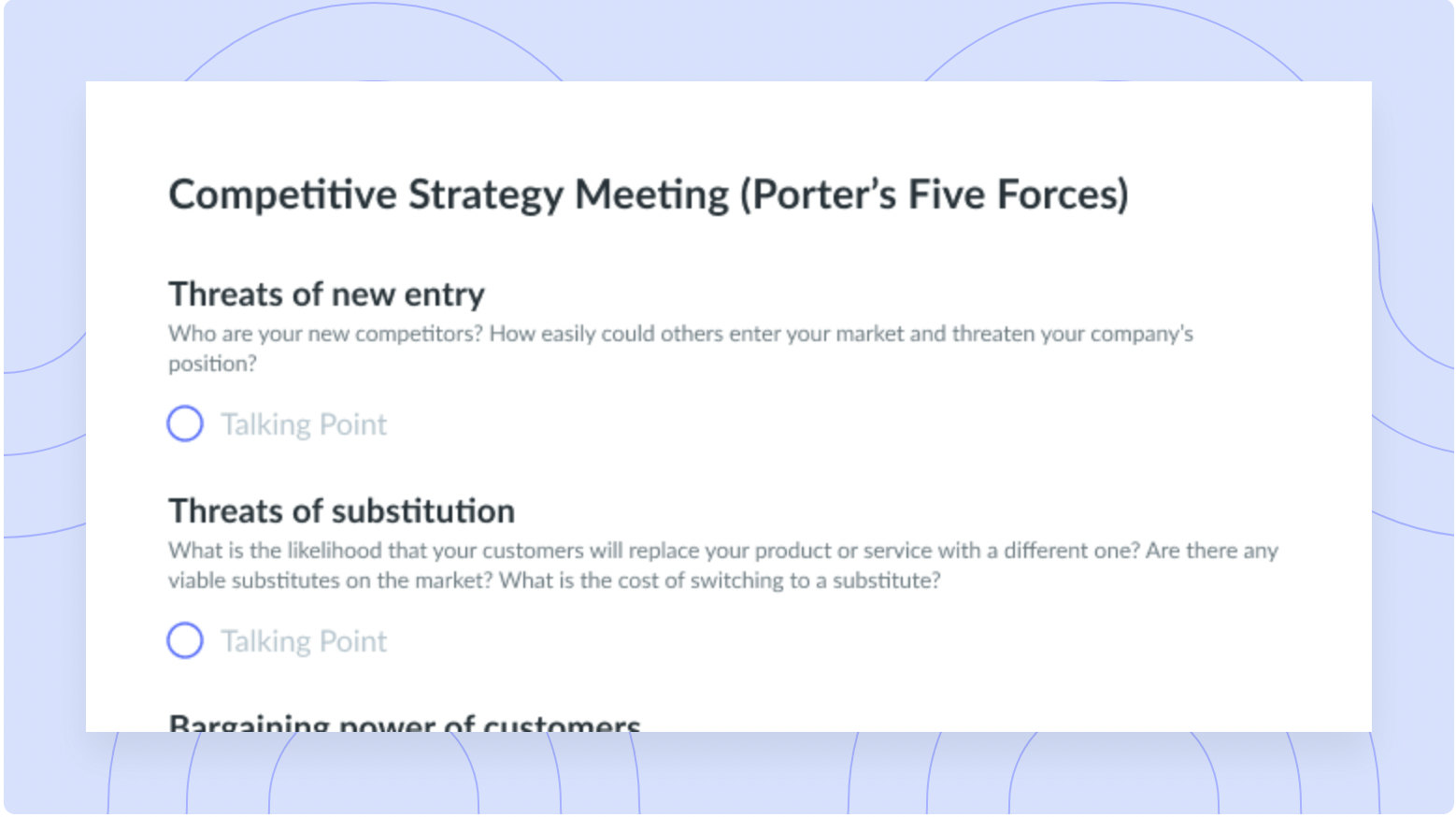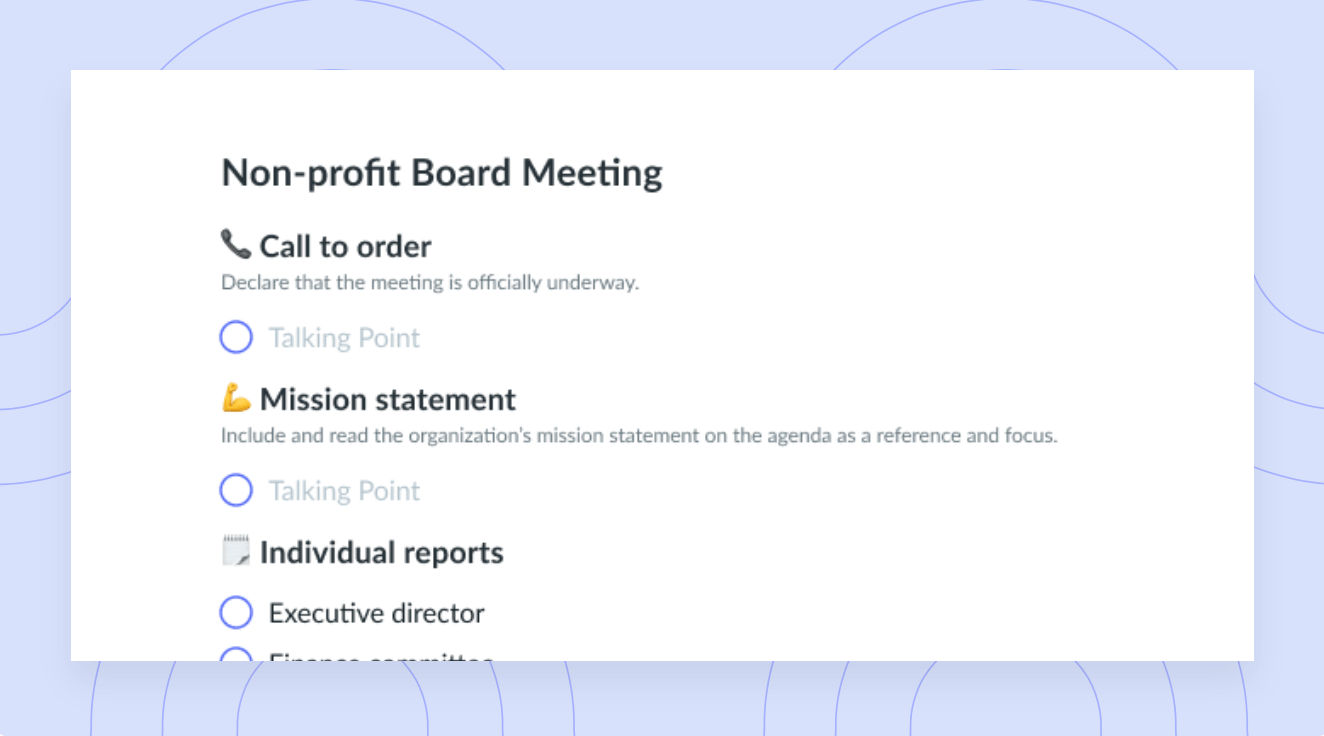Understanding the Workplace Chain of Command
Determine if the chain of command is the hierarchical structure you need to enhance productivity and motivation in your organization.
Have you been considering implementing the chain of command within your organization? Before exploring whether this hierarchical framework is for you, it’s important to first understand the advantages and disadvantages. When leveraged correctly, the chain of command can enhance decision making, make delegation a breeze, and provide employees with an extra dose of motivation. When used poorly, the chain of command can have a myriad of negative effects on your team including poor employee morale, unhealthy competition among peers, and reduced flexibility.
Understanding the workplace chain of command as outlined in this article will provide you with the insights necessary to determine whether this hierarchical framework is what you need to enhance productivity and motivation among your team or if it’s worth exploring alternatives. In this article, we’ll explain what a chain of command is, define the traditional command structure, discuss the advantages and disadvantages of a command structure, and provide answers to frequently asked questions.
- What is a chain of command?
- Advantages of establishing a chain of command
- Disadvantages of establishing a chain of command
- Chain of command structures
- Free meeting agenda templates
What is a chain of command?
A chain of command is a hierarchical structure within an organization that ranks employees from lowest to highest. This hierarchical structure identifies who reports to whom, as well as the roles and responsibilities of each employee. Understanding the command structure can help employees gain clarity while determining for what they’re responsible. For example, a chain of command may include an individual contributor who reports to a manager, who reports to a director, who reports to the chief operating officer, who reports to the chief executive officer. The chain of command is in place to let employees know to whom they should report in addition to where they fit within the organization.

Run efficient meetings, come to a decision, and get back to work
Level up your meeting habits to boost engagement and productivity with a collaborative meeting agenda. Try a tool like Fellow!

Advantages of establishing a chain of command
- Promotes accountability
- Improves decision making
- Boosts productivity
- Encourages delegation
- Motivates employees
1Promotes accountability
The chain of command establishes a clear reporting structure, meaning everyone within the chain of command understands who their immediate supervisor is and to whom they are accountable. Each level within the chain of command is also responsible for certain tasks, meaning employees always know for what they’re responsible and managers understand how to support them accordingly. This clarity helps foster a sense of ownership and accountability; this accountability leads to greater efficiency, improved performance, and a unified workforce prepared to work as one toward achieving organizational objectives. If you struggle to foster accountability within your team, it may be time to leverage a meeting management tool like Fellow. Fellow helps promote accountability by providing an intuitive way to assign action items that can be visualized, tracked, and prioritized in one place.

2Improves decision making
During the decision-making process, the chain of command provides structure, accountability, and efficiency. In addition to outlining the hierarchical structure of an organization, the chain of command outlines the hierarchy of decision making, ensuring decisions are made at the appropriate level and each manager is accountable for the decisions they make within their scope of responsibility. A clear chain of command also promotes consistency in decision making. Decisions made at each level are made carefully and methodically, leading to a more consistent approach to both decision making and problem solving.
3Boosts productivity
The chain of command defines roles and responsibilities at each level of the chain of command, eliminating miscommunications and helping employees understand exactly what is expected of them. This clarity ensures everyone within the organization is aligned and working within their lane, eliminating missed deadlines and ensuring proper resource allocation. Not only does the chain of command boost productivity by fostering clarity, but it also creates a structured framework for communication, decision making, and resource management.
Interested in taking your productivity to the next level? Fellow drives engagement and productivity before, during, and after every meeting by fostering accountability, encouraging continuous improvement, and enabling important conversations. Plus, with Fellow’s Chrome extension, you can access your meeting notes right inside of Google Meet calls and your Google Calendar to supercharge team meetings and 1-on-1s without leaving the tools that you are already using.

4Encourages delegation
The chain of command encourages delegation by creating a structured framework for decision making, task assignment, and communication. Because there is a clear line of authority within the chain of command, peers know exactly who is responsible for what task and who has the authority to delegate tasks. When employees understand their reporting relationships, it becomes easier to delegate and assign tasks based on employees’ strengths and expertise.
5Motivates employees
A clearly defined chain of command can create a positive work environment where employees feel supported, valued, and motivated to contribute to greater organizational goals. Because the chain of command provides employees with a detailed framework pertaining to their roles, responsibilities, and working relationships, they are able to understand what’s expected of them and how their work contributes to shared goals and objectives. As employees fulfill their responsibilities and meet expectations within the chain of command, they experience fulfillment, and this sense of accomplishment serves as motivation for the future.
Disadvantages of establishing a chain of command
- Makes open communication more difficult
- Increases competition
- Affects customer satisfaction
- Lowers morale
- Reduces flexibility
1Makes open communication more difficult
Because the chain of command clearly defines roles, responsibilities, and reporting structures, it makes open communication extremely difficult. This structure may prevent top-level and front-line employees from reaching out to the appropriate parties if the chain of command doesn’t explicitly show their connection.
To effectively streamline communication, thousands of leaders at companies like Shopify, SurveyMonkey, Webflow, and Gong.io have been using Fellow to optimize and improve internal communication. Fellow empowers managers to optimize meetings and improve communication by creating a hub to collaborate on meeting agendas, assign action items, get suggested conversation topics, and exchange feedback.

2Increases competition
While there are many undeniable benefits of the chain of command, one of the biggest downfalls is the competition that this hierarchical structure ignites among employees. While a little healthy competition can have positive impacts on teammates, too much competition can create a toxic work environment that hinders collaboration and fosters vindictive behavior. To maximize the positive effects of this hierarchical structure, organizations must implement fair performance measurement systems, recognition practices, and career development opportunities that promote healthy competition that in turn contributes to a positive work environment.
3Affects customer satisfaction
If not managed correctly, the chain of command can have several negative effects on customer satisfaction, including slow decision making, a lack of problem solving and accountability, miscommunication, and inconsistent customer experiences. To mitigate these effects, organizations must train employees at all levels to provide exceptional customer service while developing a customer-centric culture that values responsiveness and kindness. Creating and implementing guidelines for resolving customer queries and escalating concerns only when necessary will ensure customers receive exceptional service, regardless of the employee’s rank.
4Lowers morale
The chain of command clearly depicts each employee’s role and responsibilities, meaning
they can’t often grow or operate autonomously. Common challenges that often lead to low employee morale when embracing a chain of command include limited opportunity for input, lack of recognition, limited career growth opportunities, resistance to new ideas, and an emphasis on rank. This may result in employees who feel frustrated, underappreciated, or less motivated.
5Reduces flexibility
In a rapidly changing business environment, flexibility and adaptability are key. The chain of command hinders flexibility by providing a rigid structure that must be followed. The formalized reporting lines and decision-making processes that come with the chain of command can hinder an organization’s ability to pivot and adapt to market trends or technological advancements, making it difficult to remain relevant and competitive. Because of this rigid structure, employees often prioritize tasks based on their specific roles, ignoring or overlooking potential opportunities for change.
Chain of command structures
Top-level management
Top-level management usually consists of the board of directors, chief executive officer (CEO), chairperson, president, vice president, and owner of the company. Additional top-level managers include:
- Directors
- Chief financial officer (CFO)
- Chief operating officer (COO)
- Chief marketing officer (CMO)
- Chief technology officer (CTO)
Middle-level management
Mid-level management typically consists of:
- Foreman
- Branch managers
- General managers
- Division managers
- Department managers
Bottom-level employees
Bottom-level employees typically consist of:
- Project heads
- Office managers
- Financial analysts
- Sales representatives
- Human resource generalists
Free meeting agenda templates
The key to operating efficiently while embracing the chain of command is fostering open and honest communication among ranks. These free meeting templates encompass everything you need to improve communication between different chains of commands, ensuring that information, decisions, and instructions flow efficiently throughout the hierarchy.

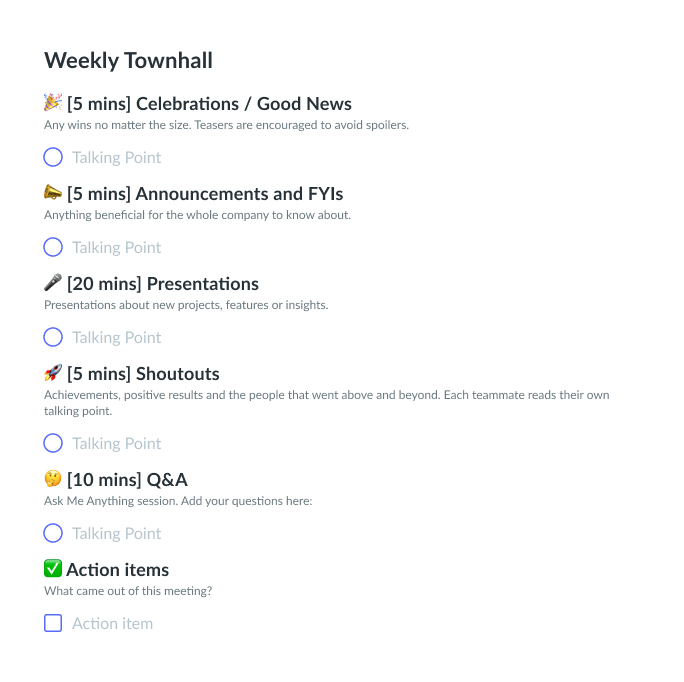


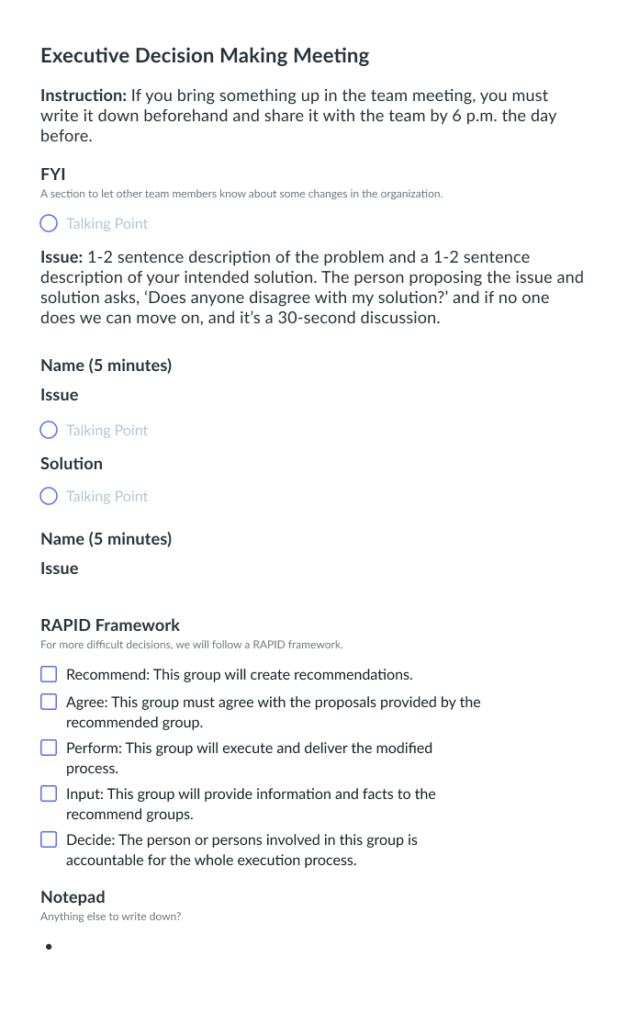
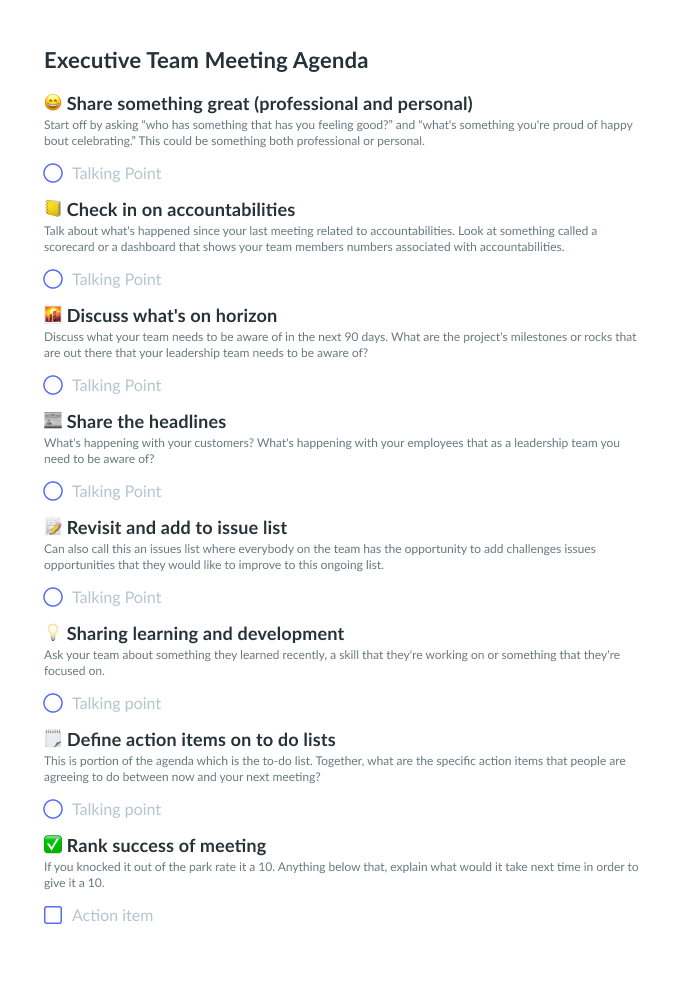
Are you prepared to embrace the chain of command?
Whether or not you implement the chain of command within your organization largely depends on your organization’s goals and aspirations. If you’re eager to implement a structured framework that defines reporting relationships, hierarchies, and roles and responsibilities, the chain of command may be exactly what you’ve been searching for. In addition to reviewing the pros and cons as outlined in this article, it’s important to strike the perfect balance between structure and flexibility. When embracing the chain of command, you must embrace structure and flexibility equally, ensuring your organization remains adaptable and responsive to changing environments.











